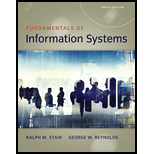
The description of the members of hierarchy of data.
Explanation of Solution
The
Bit is the smallest member in the data hierarchy. Bits represent the values of a circuit as either on or off. A combination of 8-bits called byte is used to represent any character in a computer system.
Character is the next member of the data hierarchy. Each byte represents a character. Character can have any values ranging from A to Z, a to z, 0 to 9 or any special character. Character forms the basic building block for information.
Field is formed when multiple characters are put together. Fields can have any name, number, address or any combination of character. Some fields are evaluated out of other fields like sum, average and so on.
Record is the next member of the data hierarchy. A collection of related data fields forms a record. So, in a record, there will be description of an individual or object.
File is formed with the collection of the record related to each other. For example, an employee file will contain the record of employees. In the record, there will be the fields like Name, Address, and Employee id and so on.
Database is the last member of the data hierarchy. Database consists of related files.
Want to see more full solutions like this?
Chapter 3 Solutions
Fundamentals of Information Systems
 Fundamentals of Information SystemsComputer ScienceISBN:9781337097536Author:Ralph Stair, George ReynoldsPublisher:Cengage Learning
Fundamentals of Information SystemsComputer ScienceISBN:9781337097536Author:Ralph Stair, George ReynoldsPublisher:Cengage Learning Principles of Information Systems (MindTap Course...Computer ScienceISBN:9781305971776Author:Ralph Stair, George ReynoldsPublisher:Cengage Learning
Principles of Information Systems (MindTap Course...Computer ScienceISBN:9781305971776Author:Ralph Stair, George ReynoldsPublisher:Cengage Learning Enhanced Discovering Computers 2017 (Shelly Cashm...Computer ScienceISBN:9781305657458Author:Misty E. Vermaat, Susan L. Sebok, Steven M. Freund, Mark Frydenberg, Jennifer T. CampbellPublisher:Cengage Learning
Enhanced Discovering Computers 2017 (Shelly Cashm...Computer ScienceISBN:9781305657458Author:Misty E. Vermaat, Susan L. Sebok, Steven M. Freund, Mark Frydenberg, Jennifer T. CampbellPublisher:Cengage Learning Fundamentals of Information SystemsComputer ScienceISBN:9781305082168Author:Ralph Stair, George ReynoldsPublisher:Cengage Learning
Fundamentals of Information SystemsComputer ScienceISBN:9781305082168Author:Ralph Stair, George ReynoldsPublisher:Cengage Learning Database Systems: Design, Implementation, & Manag...Computer ScienceISBN:9781305627482Author:Carlos Coronel, Steven MorrisPublisher:Cengage Learning
Database Systems: Design, Implementation, & Manag...Computer ScienceISBN:9781305627482Author:Carlos Coronel, Steven MorrisPublisher:Cengage Learning





